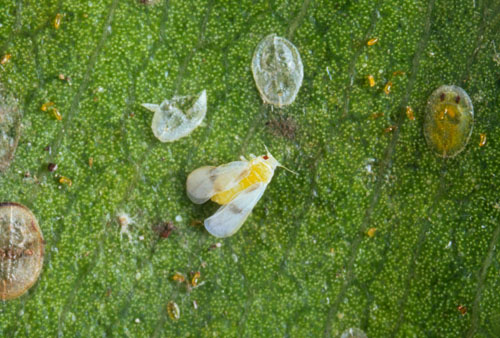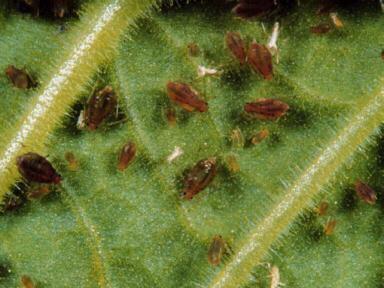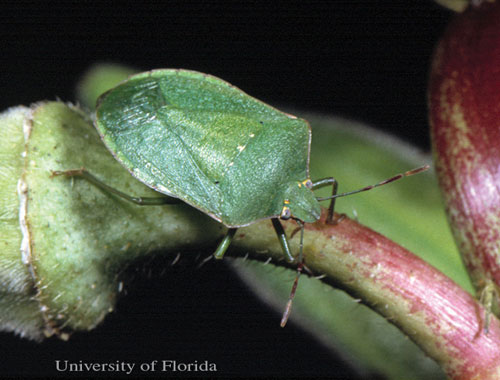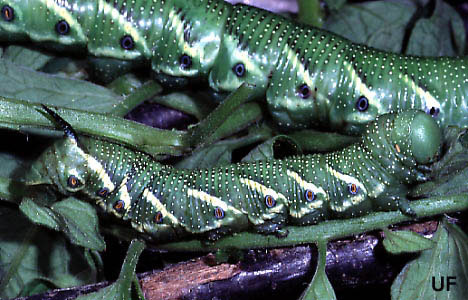Weekend Gardening: Tomato Pests
June 16, 2012
June is prime time for growing tomatoes here in Escambia County, but it’s also the best time to see a lot of pests in tomatoes that can totally ruin a crop. To help you figure out what’s “bugging” your tomatoes, here’s a quick rundown of some of the pests that you might see in your garden. Much of the information in this article was adapted from the University of Florida EDIS (Electronic Data Information Source) publication Insect Management for Tomatoes, Peppers, and Eggplant. Management techniques for the pests will be found in the full publication.
Click any photo to enlarge.
Silverleaf Whitefly
 The adult silverleaf whitefly is small, approximately 1/16 of an inch in length, and has powdery white wings held tent-like while at rest over a yellow body. Whiteflies are usually found on the undersides of leaves. Eggs, which are yellow and football-shaped, are attached upright by a tiny stalk inserted into the lower leaf surface. A mobile first instar (growth stage), or crawler stage, hatches from the egg and settles on the leaf. It then develops through immobile second, third, and fourth instars which look like semi-transparent, flat, oval scales. The fourth instar or “pupa” is more yellow and more easily seen without the aid of a hand lens, and typically has very distinct eyespots, and is referred to as a “red-eyed nymph.”
The adult silverleaf whitefly is small, approximately 1/16 of an inch in length, and has powdery white wings held tent-like while at rest over a yellow body. Whiteflies are usually found on the undersides of leaves. Eggs, which are yellow and football-shaped, are attached upright by a tiny stalk inserted into the lower leaf surface. A mobile first instar (growth stage), or crawler stage, hatches from the egg and settles on the leaf. It then develops through immobile second, third, and fourth instars which look like semi-transparent, flat, oval scales. The fourth instar or “pupa” is more yellow and more easily seen without the aid of a hand lens, and typically has very distinct eyespots, and is referred to as a “red-eyed nymph.”
As the plant grows, leaves bearing the maturing nymphs are found lower down on the plant, so older nymphs can be found by looking at older leaves. Whiteflies ingest sap from the plant vascular system (phloem) through stylets similar to those of aphids and, like aphids, process a relatively large volume of plant sap by excreting excess liquid in the form of a sugary substance called honeydew. The honeydew will result in sooty mold—a black, powdery looking substance that reduces photosynthesis in the leaves. Sometimes the nymphs will feed on the fruit and that will cause white tissue on the inside of the fruit walls.
Aphids
 Aphids are soft-bodied, sucking insects that can rapidly colonize plants due to their short life cycle. Adults are delicate, pear- or spindle-shaped insects with a posterior pair of tubes (cornicles), which project upward and backward from the end of the abdomen and which are used for excreting a defensive fluid. In Florida, winged and wingless forms are all female and give birth to living young (nymphs). Nymphs are smaller but otherwise similar in appearance to wingless adults, which they become in 7 to 10 days.
Aphids are soft-bodied, sucking insects that can rapidly colonize plants due to their short life cycle. Adults are delicate, pear- or spindle-shaped insects with a posterior pair of tubes (cornicles), which project upward and backward from the end of the abdomen and which are used for excreting a defensive fluid. In Florida, winged and wingless forms are all female and give birth to living young (nymphs). Nymphs are smaller but otherwise similar in appearance to wingless adults, which they become in 7 to 10 days.
Heavy aphid infestations may cause stunting and leaf distortion. Feeding on blossoms reduces fruit set. Sooty mold will grow on the honeydew that the aphids excrete. Aphids may also spread plant viruses.
Brown and Green Stink Bugs and Leaf-footed bugs
 Like aphids and whiteflies, true bugs are sucking insects. True bugs can be recognized by their front wings, which are leathery close to the body but membrane-like at the tips. Nymphs resemble adults in shape but are often colored differently and do not have fully developed wings. Stink bugs are green or brown shield-shaped bugs 1/2 to 2/3 of an inch long. Eggs are barrel-shaped and found on the undersides of leaves in masses of 10 to 50.
Like aphids and whiteflies, true bugs are sucking insects. True bugs can be recognized by their front wings, which are leathery close to the body but membrane-like at the tips. Nymphs resemble adults in shape but are often colored differently and do not have fully developed wings. Stink bugs are green or brown shield-shaped bugs 1/2 to 2/3 of an inch long. Eggs are barrel-shaped and found on the undersides of leaves in masses of 10 to 50.
Leaf-footed bugs are dark-colored true bugs with parallel sides. Eggs are metallic and ovate but somewhat flattened laterally and laid in clusters. Some leaf-footed bugs lay their eggs end-to-end in a single row or chain along a stem or leaf midrib. Nymphs are oblong in shape and red in color, especially on the abdomen.
Nymphs and adults of both stink bugs and leaf-footed bugs suck juices from green fruit leaving a puncture which later may become surrounded by a discolored zone due to invasion of secondary pathogens. Stink bug feeding punctures are often surrounded with a lightened, sometimes depressed, blotch beneath the fruit surface caused by the removal of cell contents and the enzymes injected by the bug. Leaf-footed punctures may cause fruit to become distorted as they enlarge
Tomato Hornworm
 There are many caterpillars that can feed on tomatoes but the tomato hornworm can strip a plant of leaves in a few days. The adult moth is large with mottled brown forewings that are longer than the lighter brown hind wings. The sides of the abdomen have five yellow spots on the sides. The female moth will lay eggs on the upper and lower surfaces of leaves. The adult moths are nectar feeders on many flowers and may be seen in the early evening around gardens and flowers.
There are many caterpillars that can feed on tomatoes but the tomato hornworm can strip a plant of leaves in a few days. The adult moth is large with mottled brown forewings that are longer than the lighter brown hind wings. The sides of the abdomen have five yellow spots on the sides. The female moth will lay eggs on the upper and lower surfaces of leaves. The adult moths are nectar feeders on many flowers and may be seen in the early evening around gardens and flowers.
The emerging caterpillars will feed on leaves and go through several molts as they develop into large green caterpillars with a black ‘horn’ on the tip of the abdomen. Caterpillars are also identified by the white or yellow ‘V’ marks on the sides of the abdomen. When it is time to pupate, the caterpillars drop to the soil and make a cell for changing to the adult moth. The pupa is reddish brown and has a loop structure at the head that contains the mouthparts. There are normally two generations of tomato hornworm a year and as late summer arrives, the hornworm goes through a resting phase.
Other plants in the tomato family can be eaten by tomato hornworms but tomatoes are the favorite in our area. The caterpillars will eat entire leaves and initially work their down on the plant, eating leaves, blossoms, and even green fruit. Because they blend in with green foliage, a homeowner will often overlook the caterpillar despite its large size.
Hornworm does have natural enemies so be cautious before reaching for the insecticide. They can also be easily handpicked and destroyed after you find them.
If you would like further information, please contact the Escambia County Extension office, (850) 475-5230.
Comments
2 Responses to “Weekend Gardening: Tomato Pests”



I’ve got several sunflowers growing this year to “assist” my tomatoes, and just today found a green stinkbug. Have never had them here in so. Calif., Have been researching these “stinkers” and have found out something fascinating… the sunflowers work! Those funny little bugs I’d been seeing all over the stalks of my suns have actually been the Brown Marmorated stink bug. Of note, SBs (green ones) are often difficult to see and usually go unnoticed as they spend much of the day on the ground beneath tomato plants. I found the green stinker on my tomato at dusk, so hopefully if there are more, they’ll move over to the suns! .. Hope that gives you some hope. BTW, all the sites I went to said this is one of the worst years they’ve seen (as far as commercial growing)
I’m trying to protect my tomato plants this year by having sunflowers close by. Supposedly the stink bugs like them better and will leave tomatoes alone,